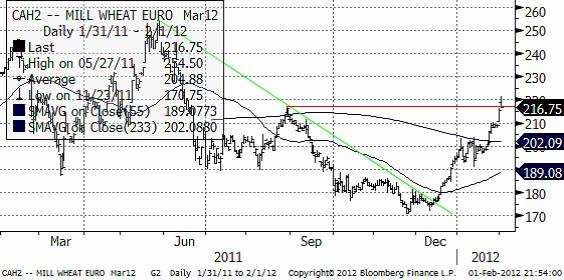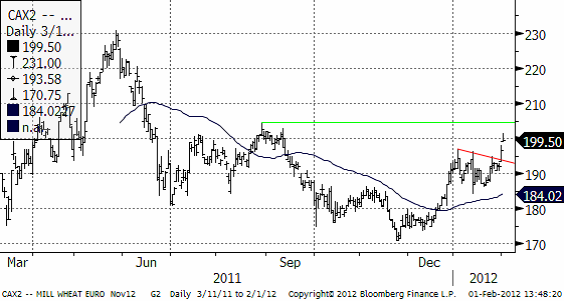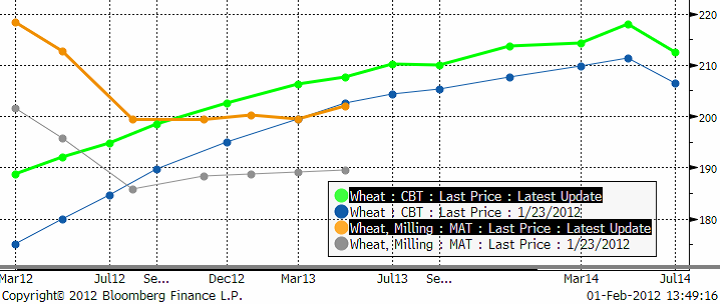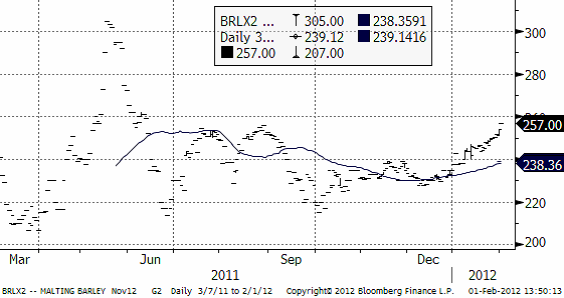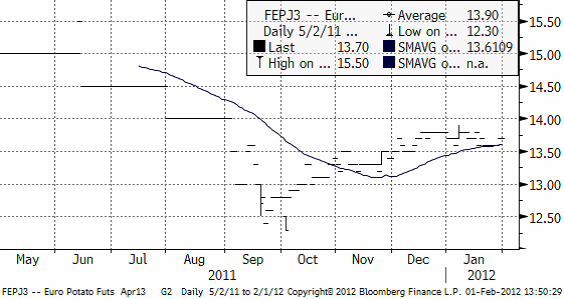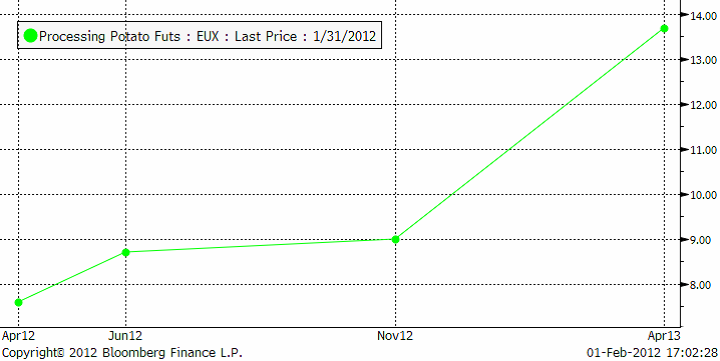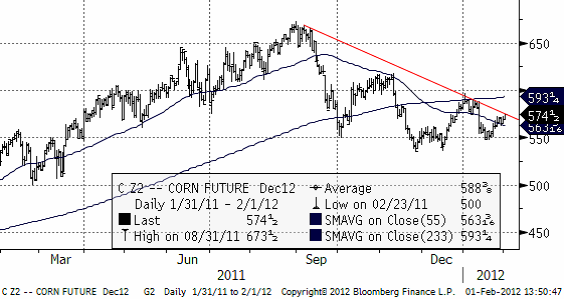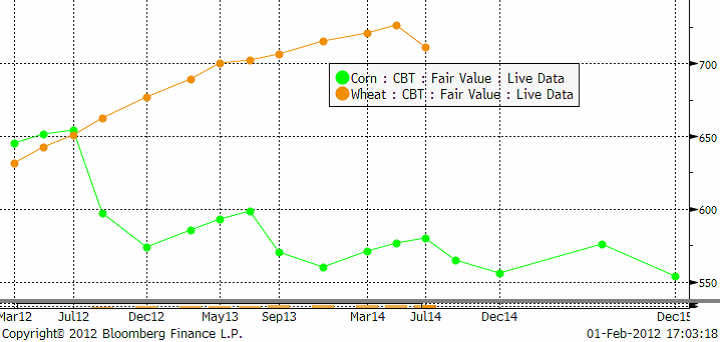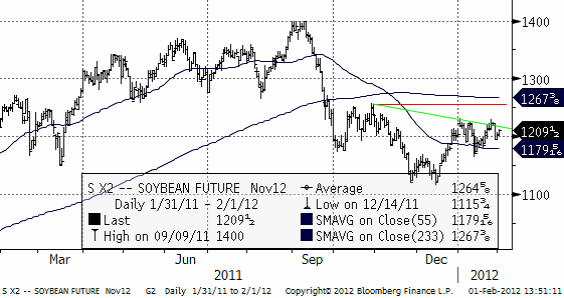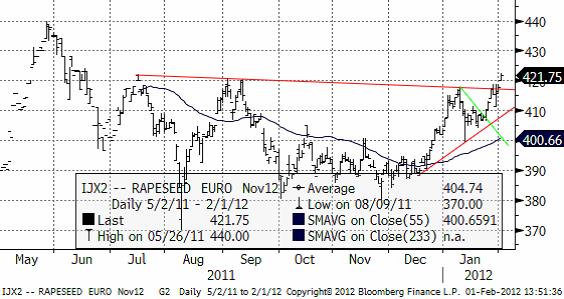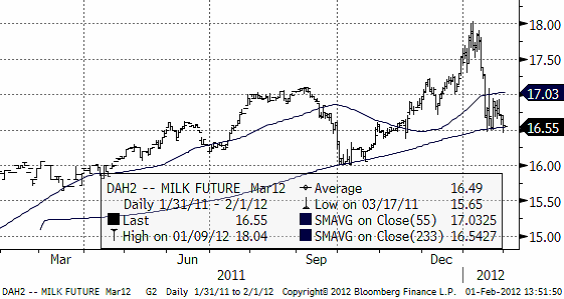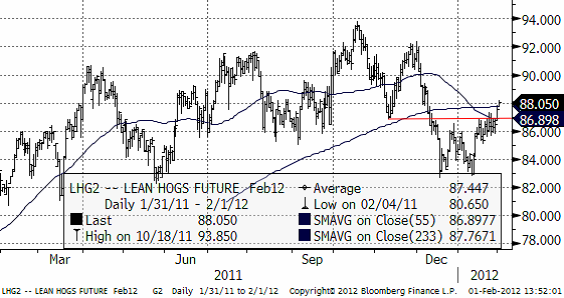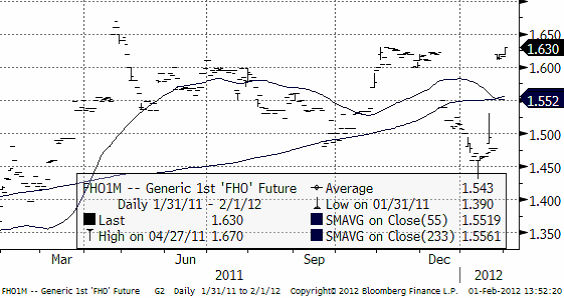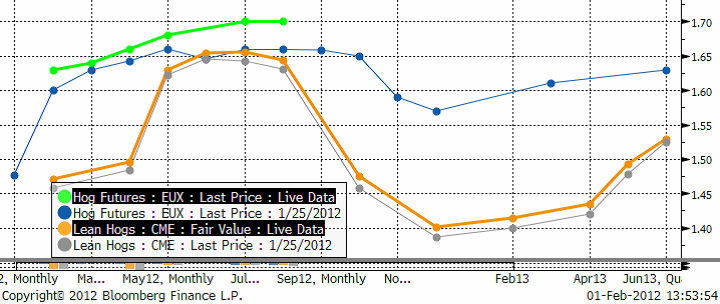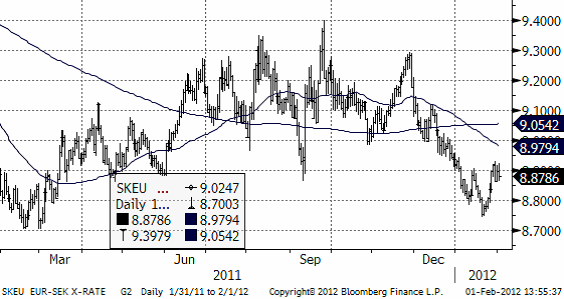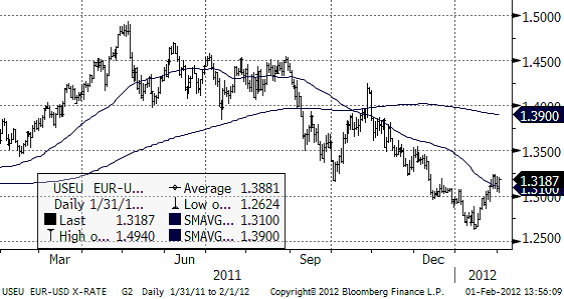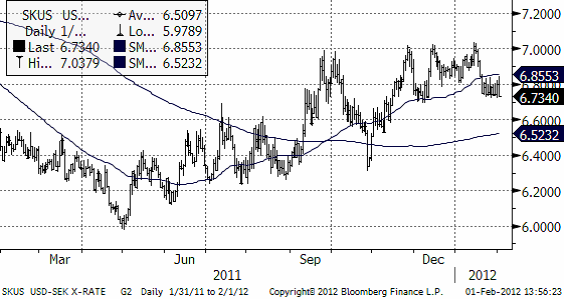Analys
SEB – Jordbruksprodukter, vecka 5 2012
 Vinnare sedan föregående vecka har de olika veteterminerna varit med uppgångar på 4 till 5%. Eurex-terminerna på tyska grisar ligger 10% högre den här veckan, men det beror bara på att vi nu tittar på ett längre terminskontrakt än förra veckan. Det är dock en liten prisuppgång på gris i Europa och också en liten i USA.
Vinnare sedan föregående vecka har de olika veteterminerna varit med uppgångar på 4 till 5%. Eurex-terminerna på tyska grisar ligger 10% högre den här veckan, men det beror bara på att vi nu tittar på ett längre terminskontrakt än förra veckan. Det är dock en liten prisuppgång på gris i Europa och också en liten i USA.
I fokus för vetemarknaden har oron för ryskt exportstopp varit. Marknaden har också oroat sig för det kalla och torra vädret i Ryssland.
Oron för torkan i Argentina har lagt sig och när nederbörden kommit tillbaka anses majsskörden kunna stabilisera sig på 18 – 22 mt (USDA:s senaste WASDE låg på 23 mt). WASDE släpps nästa vecka.
Vete
Oro över det kalla vädret i Ryssland och Östeuropa samt ett eventuellt införande av ett ryskt exportförbud har fortsatt att driva vete priset uppåt.
Den ryska regeringen diskuterar frågan om att eventuellt införande av skatter / tullar på spannmålsexporten för att bromsa den höga exporttakten.
Jordbruksministeriet i Ryssland övervakar dock kontinuerligt volymen som exporteras, och som fortfarande är stabil, och kommer att basera sitt beslut på den volym som har exporterats per februari månad. I mitten av februari kommer regeringen att kunna estimera volymen för hela månaden och då ta ställning i frågan.
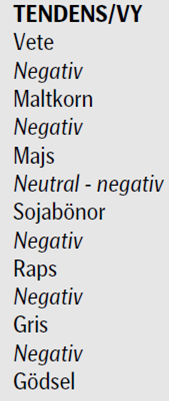 Samtidigt betonar ministeriet att detta inte kan komma som någon överraskning för marknaden och att informationen som har cirkulerat om att skatter / tullar ska införas per april 2012 är ”helt grundlösa”. Som vi har skrivit om tidigare var Putin ute redan i oktober och pratade om att spannmålsexporten för 2011/12 skulle komma att uppgå till 24-25 miljoner ton och därefter skulle eventuella restriktioner införas för att inte ”landet skulle bli utan bröd och för att upprätthålla lager”.
Samtidigt betonar ministeriet att detta inte kan komma som någon överraskning för marknaden och att informationen som har cirkulerat om att skatter / tullar ska införas per april 2012 är ”helt grundlösa”. Som vi har skrivit om tidigare var Putin ute redan i oktober och pratade om att spannmålsexporten för 2011/12 skulle komma att uppgå till 24-25 miljoner ton och därefter skulle eventuella restriktioner införas för att inte ”landet skulle bli utan bröd och för att upprätthålla lager”.
Rosstat’s statistik visar att produktionen av spannmål och baljväxter i Ryssland under 2011 uppgår till 93.9 miljoner ton, inklusive 56,2 miljoner ton vete, 16,9 miljoner korn, 6,7 miljoner ton majs och 14,1 milj i andra sädesslag och baljväxter. Detta är en uppgång med 54 procent sedan 2010 då landet led av svår torka. Veteproduktionen är upp 36% och produktionen av korn har mer än fördubblats. Det är dock bara 3 procent högre än det 5-åriga genomsnittet. Majsproduktionen matchar rekordåret 2008. Den enorma ökningen är nästan helt och hållet avkastningsrelaterad, då odlad areal endast ökade med 1 procent från 2010 till 43,6 miljoner hektar.
Som ett resultat av den stora spannmålsskörden ökade också exporten av spannmål kraftigt under första halvan av året (juli – december 2011) där Ryssland exporterade över 18 miljoner ton spannmål och baljväxter, inklusive 14,8 miljoner ton vete och det var tre av Rysslands södra regioner (Rostov oblast, Krasnodar och Stavropol krays) som stod för 85 procent av och den totala exporten. Den totala exporten för 2011/12 väntas nå 24 miljoner ton. Trots de höga exportsiffrorna under det första halvåret kommer det att bli en betydlig nedgång i exporttakten under den andra halvan av 2011/12 (januari – juni). Dels är exportpotentialen från de tre södra regionerna i stort sett klar och kommer därmed att vara nästan obefintlig de sista månaderna, dels är det problem med logistiken under vinterhalvåret. Den inhemska efterfrågan på spannmål till foderindustrin är också fortsatt stark och lagren av spannmål för export har minskat.
Vädret har också ställt till det i Ukraina då svårt frost i de flesta ukrainska regioner dramatiskt har bromsat takten på landets spannmålsexport.
En temperatur på runt minus 20 grader gör det i stort sett omöjligt att lasta spannmål på järnvägsvagnar inne i landet medan stark vind och snö hindrar lastningen i hamnarna och flera stora fartyg ligger bara och väntar.
Nedan ser vi kursdiagrammet för marskontraktet på Matif, där priset rusat över motståndet på 217, men faktiskt gick ner på onsdagskvällen och stängde under. Det är en negativ signal.
Nedan ser vi novemberkontraktet, som inte bröt ur sin konsolidering i tisdags morse, men som ännu inte nått motståndsnivån på 205 euro.
Matif har gått ännu mer i backwardation och contangot har minskat för Chicagovetet. Det talas om att den europeiske bonden inte säljer något, utan sitter och håller på sin spannmål. Vi tänker, det kan bli trångt i dörren framåt våren, när alla vill sälja samtidigt.
Vi tror att vi såg en ”key reversal day” igår i och med att marskontraktet tvärvände under dagen och stängde på den lägsta nivån. Ett sådant omslag från uppgång till tvär nedgång brukar vara värt att ta fasta på.
Maltkorn
Maltkornet har handlats upp eftersom vetet handlats upp. Det finns inget specifikt att säga om maltkornet.
Potatis
Priset på industripotatis ligger kvar på samma nivå som förra veckan för skörd 2012.
Nedan ser vi terminskurvan framåt i tiden. Årets låga priser väntas alltså inte bestå.
Majs
Väntad skörd i Argentina håller på att stabilisera sig på 18-21 mt, som är lägre än vad USDA förutspådde i januari-WASDE. Nedan ser vi att priset på decemberkontraktet ligger precis under en motståndslinje. Brott upp genom den är ett tecken på styrka och att vi i så fall skulle kunna få se en fortsatt prisuppgång.
Nedan ser vi terminskurvorna för vete (contango) och majs (backwardation).
Vete är 60 punds bushel, men här har jag räknat om priserna så att de båda är uttryckta som majsens 56 punds bushels.
Sojabönor
Sodrugestvo och Grain Ukraine förutspår en rekordskörd av sojabönor i Ukraina under 2012/13. Lönsamheten är 100-150% på grödan. Bara solrosor och majs har högre lönsamhet. Det finns gott om utsäde. Förfruktsfördelarna har ett högt värde för korn och vete. Tekniskt ser finns ingen signal ännu.
Raps
Novemberkontraktet har brutit motståndet, men ännu inte gått över pristoppen i juli. Så länge det inte sker, har vi inte någon stor trendvändning.
Mjölk
Nedan ser vi priset på marskontraktet på flytande mjölk (kontakt avräknat mot USDA:s prisindex). Vi tror fortfarande att priset kan gå ner till 16 och att prisnedgången är ”halvvägs”.
Gris
Priset på lean hogs har brutit uppåt, och befinner sig därmed fortfarande i det breda intervall som priset pendlat inom det senaste året.
Priset i Europa har betett sig på samma sätt. Nedan ser vi det vid var tid kortaste terminskontraktet (närmast spot). Det ser ut som om priset stigit kraftigt, men det beror bara på att det kontrakt som var kortast tidigare förfallit och att det kortaste nu, ligger på en högre nivå pga säsongseffekten.
Valutor
EURSEK – försöker korrigera nedgången. Vi har en neutral rekommendation på både en veckas sikt och tre månaders.
EURUSD – i rekyl fortfarande Rekommendation: Neutral på en veckas sikt. Negativ på tre månader.
USDSEK – söker efter en botten i korrektionen nedåt Vi har en neutral rekommendation på en veckas sikt, men är positive på tre månader.
[box]SEB Veckobrev Jordbruksprodukter är producerat av SEB Merchant Banking och publiceras i samarbete och med tillstånd på Råvarumarknaden.se[/box]
Disclaimer
The information in this document has been compiled by SEB Merchant Banking, a division within Skandinaviska Enskilda Banken AB (publ) (“SEB”).
Opinions contained in this report represent the bank’s present opinion only and are subject to change without notice. All information contained in this report has been compiled in good faith from sources believed to be reliable. However, no representation or warranty, expressed or implied, is made with respect to the completeness or accuracy of its contents and the information is not to be relied upon as authoritative. Anyone considering taking actions based upon the content of this document is urged to base his or her investment decisions upon such investigations as he or she deems necessary. This document is being provided as information only, and no specific actions are being solicited as a result of it; to the extent permitted by law, no liability whatsoever is accepted for any direct or consequential loss arising from use of this document or its contents.
About SEB
SEB is a public company incorporated in Stockholm, Sweden, with limited liability. It is a participant at major Nordic and other European Regulated Markets and Multilateral Trading Facilities (as well as some non-European equivalent markets) for trading in financial instruments, such as markets operated by NASDAQ OMX, NYSE Euronext, London Stock Exchange, Deutsche Börse, Swiss Exchanges, Turquoise and Chi-X. SEB is authorized and regulated by Finansinspektionen in Sweden; it is authorized and subject to limited regulation by the Financial Services Authority for the conduct of designated investment business in the UK, and is subject to the provisions of relevant regulators in all other jurisdictions where SEB conducts operations. SEB Merchant Banking. All rights reserved.
Analys
Sell the rally. Trump has become predictable in his unpredictability

Hesitant today. Brent jumped to an intraday high of $66.36/b yesterday after having touched an intraday low of $60.07/b on Monday as Indian and Chinese buyers cancelled some Russian oil purchases and instead redirected their purchases towards the Middle East due to the news US sanctions. Brent is falling back 0.4% this morning to $65.8/b.

It’s our strong view that the only sensible thing is to sell this rally. In all Trump’s unpredictability he has become increasingly predictable. Again and again he has rumbled about how he is going to be tough on Putin. Punish Putin if he won’t agree to peace in Ukraine. Recent rumbling was about the Tomahawk rockets which Trump threatened on 10 October and 12 October to sell/send to Ukraine. Then on 17 October he said that ”the U.S. didn’t want to give away weapons (Tomahawks) it needs”.
All of Trump’s threats towards Putin have been hot air. So far Trump’s threats have been all hot air and threats which later have evaporated after ”great talks with Putin”. After all these repetitions it is very hard to believe that this time will be any different. The new sanctions won’t take effect before 21. November. Trump has already said that: ”he was hoping that these new sanctions would be very short-lived in any case”. Come 21. November these new sanctions will either evaporate like all the other threats Trump has thrown at Putin before fading them. Or the sanctions will be postponed by another 4 weeks or 8 weeks with the appearance that Trump is even more angry with Putin. But so far Trump has done nothing that hurt Putin/Russia. We can’t imagine that this will be different. The only way forward in our view for a propre lasting peace in Ukraine is to turn Ukraine into defensive porcupine equipped with a stinging tail if need be.
China will likely stand up to Trump if new sanctions really materialize on 21 Nov. Just one country has really stood up to Trump in his tariff trade war this year: China. China has come of age and strength. I will no longer be bullied. Trump upped tariffs. China responded in kind. Trump cut China off from high-end computer chips. China put on the breaks on rare earth metals. China won’t be bullied any more and it has the power to stand up. Some Chinese state-owned companies like Sinopec have cancelled some of their Russian purchases. But China’s Foreign Ministry spokesperson Guo Jiakun has stated that China “oppose unilateral sanctions which lack a basis in international law and authorization of the UN Security Council”. Thus no one, not even the US shall unilaterally dictate China from whom they can buy oil or not. This is yet another opportunity for China to show its new strength and stand up to Trump in a show of force. Exactly how China choses to play this remains to be seen. But China won’t be bullied by over something as important as its oil purchases. So best guess here is that China will defy Trump on this. But probably China won’t need to make a bid deal over this. Firstly because these new sanctions will either evaporate as all the other threats or be postponed once we get to 21 November. Secondly because the sanctions are explicit towards US persons and companies but only ”may” be enforced versus non-US entities.
Sanctions is not a reduction in global supply of oil. Just some added layer of friction. Anyhow, the new sanctions won’t reduce the supply of Russian crude oil to the market. It will only increase the friction in the market with yet more need for the shadow fleet and ship to ship transfer of Russian oil to dodge the sanctions. If they materialize at all.
The jump in crude oil prices is probably due to redirections of crude purchases to the Mid-East and not because all speculators are now turned bullish. Has oil rallied because all speculators now suddenly have turned bullish? We don’t think so. Brent crude has probably jumped because some Indian and Chinese oil purchasers of have redirected their purchases from Russia towards the Mid-East just in case the sanctions really materializes on 21 November.
Analys
Brent crude set to dip its feet into the high $50ies/b this week

Parts of the Brent crude curve dipping into the high $50ies/b. Brent crude fell 2.3% over the week to Friday. It closed the week at $61.29/b, a slight gain on the day, but also traded to a low of $60.14/b that same day and just barely avoided trading into the $50ies/b. This morning it is risk-on in equities which seems to help industrial metals a little higher. But no such luck for oil. It is down 0.8% at $60.8/b. This week looks set for Brent crude to dip its feet in the $50ies/b. The Brent 3mth contract actually traded into the high $50ies/b on Friday.

The front-end backwardation has been on a weakening foot and is now about to fully disappear. The lowest point of the crude oil curve has also moved steadily lower and lower and its discount to the 5yr contract is now $6.8/b. A solid contango. The Brent 3mth contract did actually dip into the $50ies/b intraday on Friday when it traded to a low point of $59.93/b.
More weakness to come as lots of oil at sea comes to ports. Mid-East OPEC countries have boosted exports along with lower post summer consumption and higher production. The result is highly visibly in oil at sea which increased by 17 mb to 1,311 mb over the week to Sunday. Up 185 mb since mid-August. On its way to discharge at a port somewhere over the coming month or two.
Don’t forget that the oil market path ahead is all down to OPEC+. Remember that what is playing out in the oil market now is all by design by OPEC+. The group has decided that the unwind of the voluntary cuts is what it wants to do. In a combination of meeting demand from consumers as well as taking back market share. But we need to remember that how this plays out going forward is all at the mercy of what OPEC+ decides to do. It will halt the unwinding at some point. It will revert to cuts instead of unwind at some point.
A few months with Brent at $55/b and 40-50 US shale oil rigs kicked out may be what is needed. We think OPEC+ needs to see the exit of another 40-50 drilling rigs in the US shale oil patches to set US shale oil production on a path to of a 1 mb/d year on year decline Dec-25 to Dec-26. We are not there yet. But a 2-3 months period with Brent crude averaging $55/b would probably do it.
Oil on water increased 17 mb over the week to Sunday while oil in transit increased by 23 mb. So less oil was standing still. More was moving.

Crude oil floating storage (stationary more than 7 days). Down 11 mb over week to Sunday

The lowest point of the Brent crude oil curve versus the 5yr contract. Weakest so far this year.

Crude oil 1mth to 3mth time-spreads. Dubai held out strongly through summer, but then that center of strength fell apart in late September and has been leading weakness in crude curves lower since then.

Analys
Crude oil soon coming to a port near you

Rebounding along with most markets. But concerns over solidity of Gaza peace may also contribute. Brent crude fell 0.8% yesterday to $61.91/b and its lowest close since May this year. This morning it is bouncing up 0.9% to $62.5/b along with a softer USD amid positive sentiment with both equities and industrial metals moving higher. Concerns that the peace in Gaza may be less solid than what one might hope for also yields some support to Brent. Bets on tech stocks are rebounding, defying fears of trade war. Money moving back into markets. Gold continues upwards its strong trend and a softer dollar helps it higher today as well.

US crude & products probably rose 5.6 mb last week (API) versus a normal seasonal decline of 2.4 mb. The US API last night partial and thus indicative data for US oil inventories. Their data indicates that US crude stocks rose 7.4 mb last week, gasoline stocks rose 3.0 mb while Distillate stocks fell 4.8 mb. Altogether an increase in commercial crude and product stocks of 5.6 mb. Commercial US crude and product stocks normally decline by 2.4 mb this time of year. So seasonally adjusted the US inventories rose 8 mb last week according to the indicative numbers by the API. That is a lot. Also, the counter seasonal trend of rising stocks versus normally declining stocks this time of year looks on a solid pace of continuation. If the API is correct then total US crude and product stocks would stand 41 mb higher than one year ago and 6 mb higher than the 2015-19 average. And if we combine this with our knowledge of a sharp increase in production and exports by OPEC(+) and a large increase in oil at sea, then the current trend in US oil inventories looks set to continue. So higher stocks and lower crude oil prices until OPEC(+) switch to cuts. Actual US oil inventory data today at 18:00 CET.
US commercial crude and product stocks rising to 1293 mb in week 41 if last nights indicative numbers from API are correct.

Crude oil soon coming to a port near you. OPEC has lifted production sharply higher this autumn. At the same time demand for oil in the Middle-East has fallen as we have moved out of summer heat and crude oil burn for power for air-conditioning. The Middle-East oil producers have thus been able to lift exports higher on both accounts. Crude oil and condensates on water has shot up by 177 mb since mid-August. This oil is now on its way to ports around the world. And when they arrive, it will likely help to lift stocks onshore higher. That is probably when we will lose the last bit of front-end backwardation the the crude oil curves. That will help to drive the front-month Brent crude oil price down to the $60/b line and revisit the high $50ies/b. Then the eyes will be all back on OPEC+ when they meet in early November and then again in early December.
Crude oil and condensates at sea have moved straight up by 177 mb since mid-August as OPEC(+) has produced more, consumed less and exported more.

-

 Nyheter4 veckor sedan
Nyheter4 veckor sedanOPEC+ missar produktionsmål, stöder oljepriserna
-

 Nyheter2 veckor sedan
Nyheter2 veckor sedanGoldman Sachs höjer prognosen för guld, tror priset når 4900 USD
-

 Nyheter3 veckor sedan
Nyheter3 veckor sedanBlykalla och amerikanska Oklo inleder ett samarbete
-

 Nyheter3 veckor sedan
Nyheter3 veckor sedanGuld nära 4000 USD och silver 50 USD, därför kan de fortsätta stiga
-
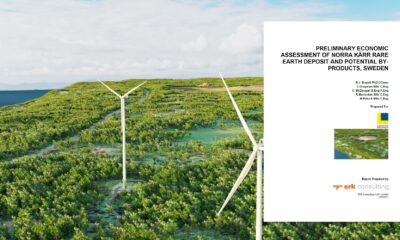
 Nyheter2 veckor sedan
Nyheter2 veckor sedanLeading Edge Materials är på rätt plats i rätt tid
-

 Nyheter2 veckor sedan
Nyheter2 veckor sedanNytt prisrekord, guld stiger över 4000 USD
-

 Nyheter3 veckor sedan
Nyheter3 veckor sedanEtt samtal om guld, olja, koppar och stål
-

 Analys3 veckor sedan
Analys3 veckor sedanOPEC+ will likely unwind 500 kb/d of voluntary quotas in October. But a full unwind of 1.5 mb/d in one go could be in the cards


